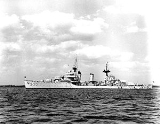
Porter class destroyer
Encyclopedia
The Porter-class destroyers were a class of eight 1,850-ton destroyers in the United States Navy
.
The first four ships were laid down in 1933 by New York Shipbuilding
and the next four in 1934 at Bethlehem Steel Corporation in Quincy, Massachusetts
. All were commissioned in 1936 except the Winslow, which was commissioned in 1937.
They were built in response to the large destroyers
that the Japanese Navy was building at the time, and were initially leaders of destroyer flotillas. They were originally built with eight Mk 12 5 inch/38 caliber (127 mm) guns in four Mark 22 Single Purpose (surface action only) twin mounts. This proved to be top heavy, and planes were becoming a greater threat, so during the war, mounts 51 and 54 were replaced with Dual Purpose (surface action and air action) twin mounts, and more smaller anti-aircraft guns were installed. In some ships, mount 52 was replaced by a quad 40 mm
mount, and mount 53 became a single 5 in/38 (127/38 mm) Dual Purpose mount. Additional 40 mm guns were added amidships.
and the large French destroyers seems to have become the tripping point with the 1930 recommendations beginning the cycle to actually build ships. The Geneva proposals about destroyers also seems to have influence the design as the Destroyer Leader proposals limited themselves to 1850 tons per the proposals. There were extensive discussions about the armament, the 5"/25 caliber AA gun being favored as being easy to work and train in a fast moving and lively type of ship. The other candidate was the 5"/51 caliber surface type, being very powerful but all but useless against aircraft. It was a discussion made more interesting as the 5"/38 caliber dual purpose gun was now becoming available and the ordinance department favored it rather strongly.
United States Navy
The United States Navy is the naval warfare service branch of the United States Armed Forces and one of the seven uniformed services of the United States. The U.S. Navy is the largest in the world; its battle fleet tonnage is greater than that of the next 13 largest navies combined. The U.S...
.
The first four ships were laid down in 1933 by New York Shipbuilding
New York Shipbuilding
The New York Shipbuilding Corporation was founded in 1899 and opened its first shipyard in 1900. Located in Camden, New Jersey on the east shore of the Delaware River, New York Ship built more than 500 vessels for the U.S...
and the next four in 1934 at Bethlehem Steel Corporation in Quincy, Massachusetts
Quincy, Massachusetts
Quincy is a city in Norfolk County, Massachusetts, United States. Its nicknames are "City of Presidents", "City of Legends", and "Birthplace of the American Dream". As a major part of Metropolitan Boston, Quincy is a member of Boston's Inner Core Committee for the Metropolitan Area Planning Council...
. All were commissioned in 1936 except the Winslow, which was commissioned in 1937.
They were built in response to the large destroyers
Fubuki class destroyer
The was a class of twenty four destroyers of the Imperial Japanese Navy. The Fubuki class has been called "the world's first modern destroyer." The Fubuki class not only set a new standard for Japanese vessels, but for destroyers around the world...
that the Japanese Navy was building at the time, and were initially leaders of destroyer flotillas. They were originally built with eight Mk 12 5 inch/38 caliber (127 mm) guns in four Mark 22 Single Purpose (surface action only) twin mounts. This proved to be top heavy, and planes were becoming a greater threat, so during the war, mounts 51 and 54 were replaced with Dual Purpose (surface action and air action) twin mounts, and more smaller anti-aircraft guns were installed. In some ships, mount 52 was replaced by a quad 40 mm
Bofors 40 mm gun
The Bofors 40 mm gun is an anti-aircraft autocannon designed by the Swedish defence firm of Bofors Defence...
mount, and mount 53 became a single 5 in/38 (127/38 mm) Dual Purpose mount. Additional 40 mm guns were added amidships.
Design
The larger Destroyer Leader type had been under active consideration since 1921. Indeed the General Board recommended the construction of five of the type in that year. Naval historian Norman Friedman believed that the great number of and rendered the U.S.Congress from purchasing them. The General Board was very interested in equipping such a type with the new higher pressure and higher temperature steam propulsion equipment. The London Naval TreatyLondon Naval Treaty
The London Naval Treaty was an agreement between the United Kingdom, the Empire of Japan, France, Italy and the United States, signed on April 22, 1930, which regulated submarine warfare and limited naval shipbuilding. Ratifications were exchanged in London on October 27, 1930, and the treaty went...
and the large French destroyers seems to have become the tripping point with the 1930 recommendations beginning the cycle to actually build ships. The Geneva proposals about destroyers also seems to have influence the design as the Destroyer Leader proposals limited themselves to 1850 tons per the proposals. There were extensive discussions about the armament, the 5"/25 caliber AA gun being favored as being easy to work and train in a fast moving and lively type of ship. The other candidate was the 5"/51 caliber surface type, being very powerful but all but useless against aircraft. It was a discussion made more interesting as the 5"/38 caliber dual purpose gun was now becoming available and the ordinance department favored it rather strongly.

